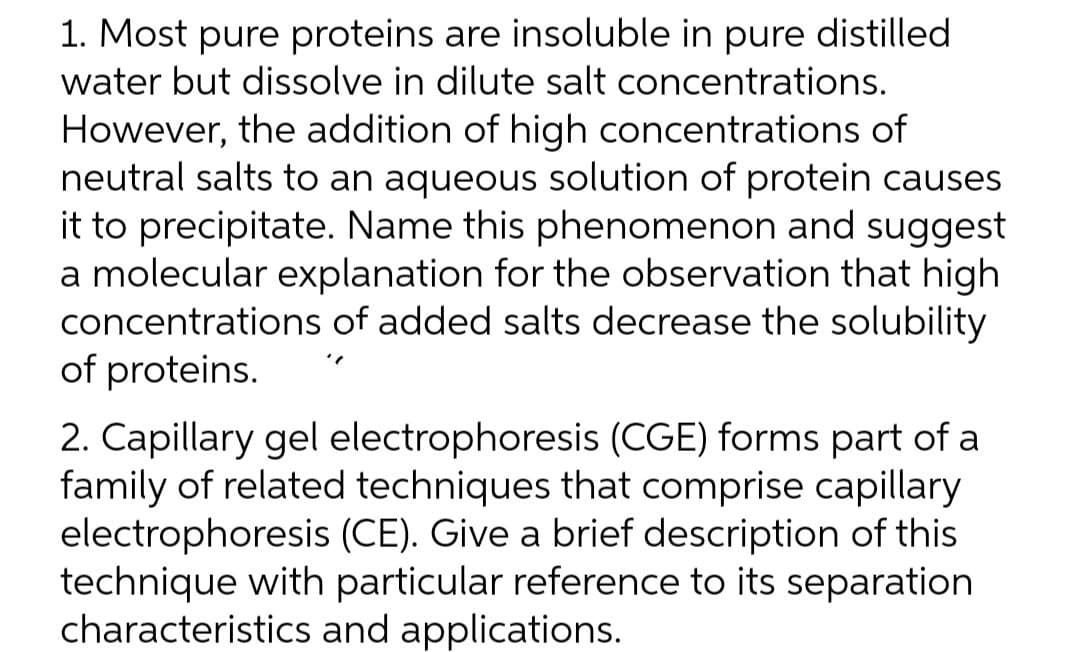1. Most pure proteins are insoluble in pure distilled water but dissolve in dilute salt concentrations. However, the addition of high concentrations of neutral salts to an aqueous solution of protein causes it to precipitate. Name this phenomenon and suggest a molecular explanation for the observation that high concentrations of added salts decrease the solubility of proteins. 2. Capillary gel electrophoresis (CGE) forms part of a family of related techniques that comprise capillary electrophoresis (CE). Give a brief description of this technique with particular reference to its separation characteristics and applications.
1. Most pure proteins are insoluble in pure distilled water but dissolve in dilute salt concentrations. However, the addition of high concentrations of neutral salts to an aqueous solution of protein causes it to precipitate. Name this phenomenon and suggest a molecular explanation for the observation that high concentrations of added salts decrease the solubility of proteins. 2. Capillary gel electrophoresis (CGE) forms part of a family of related techniques that comprise capillary electrophoresis (CE). Give a brief description of this technique with particular reference to its separation characteristics and applications.
Biochemistry
9th Edition
ISBN:9781319114671
Author:Lubert Stryer, Jeremy M. Berg, John L. Tymoczko, Gregory J. Gatto Jr.
Publisher:Lubert Stryer, Jeremy M. Berg, John L. Tymoczko, Gregory J. Gatto Jr.
Chapter1: Biochemistry: An Evolving Science
Section: Chapter Questions
Problem 1P
Related questions
Question

Transcribed Image Text:1. Most pure proteins are insoluble in pure distilled
water but dissolve in dilute salt concentrations.
However, the addition of high concentrations of
neutral salts to an aqueous solution of protein causes
it to precipitate. Name this phenomenon and suggest
a molecular explanation for the observation that high
concentrations of added salts decrease the solubility
of proteins.
2. Capillary gel electrophoresis (CGE) forms part of a
family of related techniques that comprise capillary
electrophoresis (CE). Give a brief description of this
technique with particular reference to its separation
characteristics and applications.
Expert Solution
This question has been solved!
Explore an expertly crafted, step-by-step solution for a thorough understanding of key concepts.
Step by step
Solved in 2 steps with 2 images

Recommended textbooks for you

Biochemistry
Biochemistry
ISBN:
9781319114671
Author:
Lubert Stryer, Jeremy M. Berg, John L. Tymoczko, Gregory J. Gatto Jr.
Publisher:
W. H. Freeman

Lehninger Principles of Biochemistry
Biochemistry
ISBN:
9781464126116
Author:
David L. Nelson, Michael M. Cox
Publisher:
W. H. Freeman

Fundamentals of Biochemistry: Life at the Molecul…
Biochemistry
ISBN:
9781118918401
Author:
Donald Voet, Judith G. Voet, Charlotte W. Pratt
Publisher:
WILEY

Biochemistry
Biochemistry
ISBN:
9781319114671
Author:
Lubert Stryer, Jeremy M. Berg, John L. Tymoczko, Gregory J. Gatto Jr.
Publisher:
W. H. Freeman

Lehninger Principles of Biochemistry
Biochemistry
ISBN:
9781464126116
Author:
David L. Nelson, Michael M. Cox
Publisher:
W. H. Freeman

Fundamentals of Biochemistry: Life at the Molecul…
Biochemistry
ISBN:
9781118918401
Author:
Donald Voet, Judith G. Voet, Charlotte W. Pratt
Publisher:
WILEY

Biochemistry
Biochemistry
ISBN:
9781305961135
Author:
Mary K. Campbell, Shawn O. Farrell, Owen M. McDougal
Publisher:
Cengage Learning

Biochemistry
Biochemistry
ISBN:
9781305577206
Author:
Reginald H. Garrett, Charles M. Grisham
Publisher:
Cengage Learning

Fundamentals of General, Organic, and Biological …
Biochemistry
ISBN:
9780134015187
Author:
John E. McMurry, David S. Ballantine, Carl A. Hoeger, Virginia E. Peterson
Publisher:
PEARSON